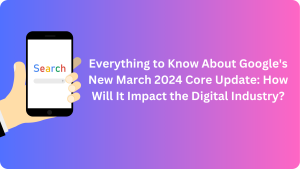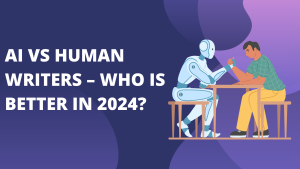Ever since tools like ChatGPT came into existence, there is been a debate over AI-generated content. However, the use of AI for creating content, especially written content, is preferred by the vast majority.
On the other hand, the percentage of people disliking the content generated by AI is also massive. These people mostly belong to digital marketing and content creation backgrounds. Their concern however is not actually about their jobs but the poor quality of content generated by AI tools.
From this debate, a question has arisen: “Does Google rank AI content?”. Some people say that yes google ranks AI content, whereas others say that AI content gets banned on Google. But the reality is that Google does rank AI content.
However, it’s not as simple as it looks, so stop if you have already initiated prompting GPT to write a “mass lay-off letter” for your writing team. Jokes apart, let’s understand what Google says about AI-generated content.
Does Google Rank AI Content Lower?
“Rewarding high-quality content, however it is produced” is what Google has to say about AI-generated content. This is not specifically for AI, but Google has the same views for any kind of automated content.
In general, Google doesn’t have any problem with AI-generated content. Not only this, but Google itself has admitted the power of AI and the transformation it will bring.
In addition, we all know the fact that how much effort Google is putting into developing AI tools and models not only for users but also to make their search engine better. So, if you create content with AI, will it rank on Google or not? Or will it rank lower?
In its blog published on Search Central, Google has said that no matter who has written or produced the content, the content will rank if it has potential. But how does Google know if the content is of high quality?
Now, there should be no doubt that Google has developed good systems to do that. But if we go by Google’s statements about it, then Google has said that EEAT and the Helpful Content Algorithm are among the essential things that are looked at to identify the quality of the content. So, since Google isn’t dictating AI and human-written content, let’s now understand how Google ranks content.
How does Google Rank Content?
Google has a lot of factors to consider when ranking content. But first, look at those to which Google has given special preference in the case of AI, that is, EEAT and the Helpful content algorithm. These two updates are launched to improve the user experience. But how?
- EEAT
It is a measure that Google has come up with to judge the content on four factors. These four factors, or the full form of EEAT, are Experience, Expertise, Authoritativeness, and Trustworthiness.
Experience means what is the writer’s experience with the content written by him/her. For example, reviews are written when you experience a service or product in hand. So, we can say that it is a first-person experience.
Similarly, if you share your views based on your research rather than only sharing what is already available on the internet, it will be counted as a first-person experience.
In the case of AI, it’s not a factor that suits AI content generation a lot, as even if AI generated first-hand content, it is through what’s available already. But looking at the prediction models based on AI, I don’t think that experience has any adverse effect on AI-generated content.
Next up is expertise. Being artificial and fed on a lot and a lot of data, AI models are mostly trained to provide results that look like they are coming from experts. So, being an expert is not a big deal for AI tools. But you may feel that your AI chatbot isn’t generating like an expert. For that, you should give it a good prompt to remove any constraints.
Authority and trustworthiness are very crucial, as promoting wrong content is not what Google likes or does. There are many instances where GPT or other AI tools end up generating factually incorrect content. So you should make sure that the content isn’t coming from unreliable sources and is factually and statistically correct by asking for the reference.
In brief, Google looks for the trustworthiness of the content and authority. The content should not propose something that can’t be verified, and the facts and stats in the content should come from reliable sources.
Also, the author should have expertise in the field that the content is about so that he/she will be able to generate better content and proofread the content with his/her expertise.
- Google Helpful Content Algorithm
This algorithm was launched and implemented by Google in 2022. The algorithm will get updated and get better day by day. However, this algorithm intends to rank the content that is helpful and not just created for the search engine. There was a misuse of Google’s SEO-based ranking strategies, which Google realized soon.
So, Google took this step to stop the top listing of the content that adds zero value for users, but it keeps ranking due to its better SEO score. While elaborating on this algorithm in a blog, Google again highlighted the EEAt and also talked about “Who, how, and why.”
Note: We will talk about this “Who, How, and Why” later in the blog.
Apart from EEAT and helpful content algorithms, other factors like on-page SEO, Off-page SEO, Technical SEO, indexing, and many more are still being done by humans. So, considering them makes no sense.
However, these things do play an important role and can result in lower ranking even if the AI-generated content is of high quality both for the user and Google.
Now, this is what EEAT and Google Helpful Content mean. Based on these factors, it can be concluded that if the AI content is relatable and helpful for users’ queries and can be trusted for whatever it has produced, then Google will not only rank the content but will rank it higher. Lastly, from an SEO perspective, the AI content should have good keyword implementation.
What advice does Google have for creators using AI?
Google has some advices for those creating content using AI like Chat GPT. According to Google, the AI-generated Content should be correct, so you should give time to the research and cross-checking parts. In simple words, proofreading AI-generated content is important.
Also, the content should be good in other factors as well, such as being easy to read and understand. Moreover, the content should be helpful for the audience, meaning you should create something that users find useful.
Now, talking about “Who, How, and Why” “Google has answered an FAQ where it was asked if the publishers should disclose whether their content is being generated with AI or not. So, the advice is that you should disclose it for the sake of the users so that they can see how the content is produced.
What exactly is the AI vs Human Written Content debate?
Now, what is this debate for if Google doesn’t have any problem with AI-generated content? The actual debate is about the generation of poor and misleading content.
Most of the Content created by AI, like ChatGPT, turns out to be very poor as the prompt is not given properly. Here’s an example for you to understand the difference between Poor AI-generated content and good AI-generated content.
Here’s what Chat GPT generated when asked, “What are No follow backlinks?”
“No follow is an HTML attribute value used in hyperlink tags to instruct search engines not to pass any authority or credit to the linked page. In other words, when a website uses the “rel=’nofollow'” attribute in a hyperlink, it signals to search engines that they should not consider that link when calculating page ranking or authority.
“No follow backlinks” are hyperlinks that have the “nofollow” attribute attached to them. These types of links are often used in situations where a website does not want to vouch for the credibility of the linked page, or when the link is paid, user-generated content (such as blog comments or forum posts), or in cases where the website wants to avoid potential penalties for manipulating search engine rankings.
From an SEO perspective, no-follow backlinks do not directly contribute to a website’s search engine ranking. Search engines, such as Google, generally do not follow these links when crawling the web, and they do not pass authority from the linking page to the linked page. However, they can still be valuable in other ways, such as driving traffic to the linked page and increasing overall visibility.
In contrast, “dofollow” links (links without the “nofollow” attribute) are the standard type of links that pass authority from one page to another, influencing the linked page’s search engine rankings. Websites typically use do-follow links when they want to endorse or vouch for the content they are linking to.”
Now, look at the readability of this content.

Here’s the result with a better prompt: “Hey GPT, I’m writing a blog defining “What are No follow backlinks.” I want you to write “What are No follow backlinks” in simple, easy-to-understand language. The tone of the content should be informational.“
“Understanding No-Follow Backlinks: A Simple Guide
When we talk about the world of websites and search engines, the term “backlink” often comes into play. Backlinks are like little pathways between different websites, and they play a crucial role in determining a site’s popularity and credibility. Now, among these backlinks, there’s a special type called “No-Follow Backlinks.”
What Exactly Are No-Follow Backlinks?
Let’s break it down. When one website links to another, it’s like a vote of confidence or a recommendation. It’s saying, “Hey, check out this cool site!” Now, in the online world, search engines use these links to understand how trustworthy and relevant a website is.
But here’s the twist with No-Follow Backlinks: they come with a tag aptly named “no-follow.” This tag tells search engines, “Don’t follow this link too closely; it’s not a full endorsement.” In simple terms, it’s a way for websites to link to each other without necessarily vouching for the other site’s credibility.
Why Use No-Follow Links?
Websites use no-follow links for various reasons. One common scenario is when a site allows user-generated content, like comments on a blog. To prevent spammy or low-quality links from affecting their reputation, the website can add a no-follow tag to these links.
Similarly, in sponsored content or advertisements, websites might use no-follow links to maintain transparency. It’s like saying, “Yes, this is a paid promotion, but we’re not necessarily vouching for the content.”
And, here’s the quality of the content.

You can see how huge the difference is. This difference is caused due to the prompts. On one side, the prompt was direct, and the result was terrible. But the other prompt was descriptive, so the result was better than the first one.
So, if one puts effort into prompting, proofreading, and editing the content, he/she will surely get great results, which, when published online, will rank and receive traffic.
But the problem is that most content creators just focus on generating content and avoid its quality and helpfulness. It leads to a bulk of poor-quality content with the intent to rank only. So, is there something Google is doing to tackle the problem?
What is Google doing to prevent Poor AI Content from Ranking?
Google has clarified that poor content, whether from humans or AI, will not be tolerated. Moreover, Google has also said it’s not the first time such a problem has occurred. Back then, people tried manipulating Google’s rankings by creating and publishing bulk content to rank on Google.
Google identified that practice, and Google is continuously coming up with the latest technology to deal with that. The same is the case with AI-generated content. Also, google will not have to do a lot to deal with bulk poor AI content as it has already developed its Algorithms a lot.
Should You Create AI Content?
So, till then, we have talked a lot about Google’s perspective on AI-generated content. Moreover, Google has no problem with where or whom your content is coming from. Your content should be of great quality, and that’s it.
But should you create AI content for your website or your clients? First, let’s look at the stats.
According to Notta, 76% of people use AI to generate basic content that shouldn’t be counted in what’s uploaded on the internet. However, the percentage of people using it for creating content copy is also the same. So, AI is being used in content creation.
Additionally, 71% of people use AI to think creatively, and 63% to analyze market data. Also, 62% of people use AI for image generation.
Based on the above data by Notta, you can see that for research purposes, the use of AI is not as prominent as for writing purposes. The same is the case with image generation. AI still has to work on generating images more precisely.
But, when it comes to AI, we can say that there’s a lot of accuracy, and that’s why people are using it to write content. Also, to think creatively, AI is helpful a lot.
The reason why content creation is comparatively more precise than other purposes is that there’s a lot of data available to train the AI.
However, if you narrow down the road and talk about marketers specifically, they have a lower adoption rate of AI. The reason is that they find AI as a tool that can help them fill their word count needs by providing them with a good outline.
That’s why only 52% of people are using it to help generate content that is too partial. Moreover, if it comes to personalized Marketing, the percentage comes down to 28%.
In totality, you can use AI for content creation, but you should know that it’s not very simple to do so. If it was, then marketers should have adopted it instantly to make more profits. If you learn to prompt better and then use AI, you will get content that can be published.
But it’s only the case until you are not demanding personalized content. So, if you want to make AI a part of your content creation process, it’s extremely important to learn it first. Otherwise, you can’t succeed by publishing the content that AI generates with prompts like “What is SEO?“.
Many companies and Content writing agencies have started AI content as a service. But they are mostly just able to do it with fewer humans and not without humans. So, human intelligence is still needed. Also, they have processes that require humans to shift from one task to another.
Such agencies have succeeded in cost-cutting and making the content creation cheaper, but most people are still not able to give a green flag to AI content for their content marketing.
Bottom Line
The use of AI still has to be assisted by humans, at least for content creation. It means that even when Google has no problem with AI-generated content, it’s important to know how to generate that type of AI content, which Google feels no need to ban.
If you want to generate AI content for yourself, your business, or your clients, it’s important to invest in yourself first. You will have to learn to prompt, and if you are a team, then you will have to establish a process efficient enough to generate helpful and high-quality content.







